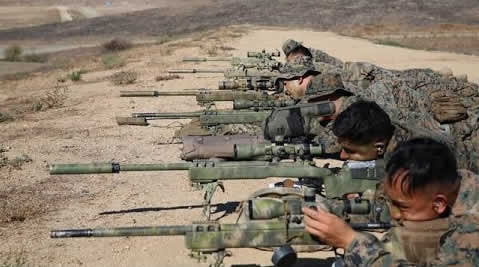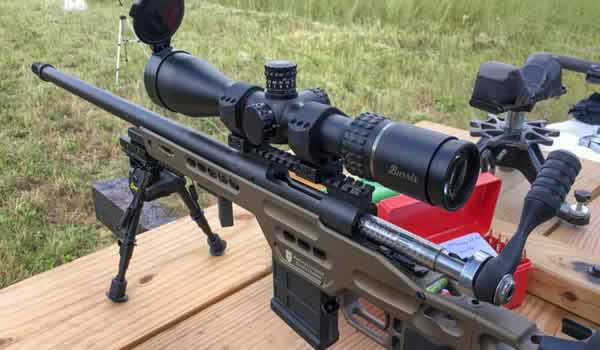MOA vs MRAD
Which is Best for Long Range Competition Shooting?
So, what do the acronyms M.O.A. and M.R.A.D. mean to shooters and what is the difference between the two? Well, the answer to that question is that M.O.A. indicates Minutes of Angle whereas, M.R.A.D. indicates Milli radians and both are angular units of measure.

Because they are both used to measure the length of a section of a circle’s circumference, shooters use either Minutes of Angle or Milli radians for measuring the adjustment range of their rifle scopes.
Although there is no inherent advantage to choosing one over the other, some shooters do have a distinct preference for Minutes of Angle over Milli radians and vice versa.
However, you should be aware that they each have both advantages and disadvantages that make each type of measurement better suited for different types of shooting situations.
How does a Long Range Rifle Scope Work
In addition, it should also be noted that long range scopes are available with both different types of reticles and different types of turrets.
Consequently, standard rifle scopes are designed with reticles that are specifically designed for relatively close range shots and turrets that are designed to enable the shooter to adjust the position of the reticle by first removing a turret cap and then using a tool such as a coin to adjust the position of the reticle.
However, long range scopes designed for shooting at extended ranges (aka “tactical scopes”) often feature both range-finding reticles and quick-adjust turrets that enable a shooter to easily adjust the position of the reticle with their fingers and then, return the reticle to its original point of aim by simply pressing down on the top of the turret.
While standard rifle scopes are often the best choice for shooting at slow moving or stationary targets at relatively close ranges, shooting at extended ranges at non-stationary targets often requires the shooter to make rapid adjustments to their scope’s point of aim and thus, tactical rifle scopes are often a better choice for this type of long range shooting.
In addition, it is important to note that even when a tactical rifle scope is chosen, the shooter still needs to make a choice between scopes that measure angles in M.O.A. or M.R.A.D.
Minutes of Angle (aka M.O.A.)
Most North American and European hunters and shooters are most familiar with Minutes of Angle, let’s examine this type of angular measurement first. Like Milliradians, Minutes of Angle are based on the length of the circumference of a circle.
When using M.O.A., the circle is divided into 360 equal parts called “degrees” and, each degree is further divided in to 60 equal parts called “minutes”. Therefore, that means that any circle of any diameter is composed of 21,600 minutes of angle.
Milliradians
Milliradians on the other hand are defined as the arc of a circle with the same length as that of the radius and are based on the ratio of the circumference of a circle that is twice the length of its radius multiplied by the mathematical constant Pi (aka 3.14).
The ratio of the circumference to the radius is always the same, there are always the same number of radians in a circle and this is true regardless of how large or small the circle is.
So, rather than dividing a circle into 360 degrees and 21,600 minutes as with M.O.A., Milliradians instead divide the circumference of a circle into 6.28 equal sections measuring 57.3 degrees each and thus, every circle has a circumference that is 6.28 radians long.
Then, each radian is further divided into 1,000 equal parts called Milliradians. Therefore there are 6,280 Milliradians in every circle compared to 21,600 Minutes of Angle.
M.O.A. vs. M.R.A.D. in relation to scope turrets
However, it should be noted that because sportsmen commonly use these measurements in relation to rifle or handgun scopes, they are commonly measured using a circle with a 100 yard radius. Then, a single Minute of Angle is equal to 1 inch at 100 yards whereas, a Milliradian is equal to 3.6 inches at 100 yards. When comparing Minutes of Angle to Milliradians, there are approximately 3.44 minutes of angle in each milliradian.
Most rifle and handgun scopes manufactured in North America and Europe are designed to use Minutes of Angle rather than Milliradians because minutes of angle provide shooters with a finer degree of measurement at closer ranges than milliradians do. However, the opposite is true when shooting at longer ranges because there are additional factors that need to be considered when shooting at extended ranges.
In addition, it should be noted that both M.O.A. and M.R.A.D. tactical scopes have different adjustment increments. For instance, M.O.A. scopes commonly feature quick-adjust turrets with half-minute, quarter-minute, and eighth-minute adjustments with each successive adjustment providing a greater degree of precision.
But, even though one-eighth minute increments are the most precise, they are only suitable for shooting at stationary targets because they require the shooter to turn the turret significantly farther to compensate for changes in the target’s range than one-quarter or one-half minute increments do.
Thus, when shooting at long ranges at a moving target or, in a situation where adjustments to the point of aim have to be made quickly, quarter-minute and half-minute increments are better choices when shooting over long distances at non-stationary targets because they enable a shooter to make adjustments in the point of aim more rapidly.
On the other hand, M.R.A.D. scopes have a single standard adjustment increment which is one-tenth of a milliradian. Consequently, because M.R.A.D. scopes use base 10 increments rather than fractional increments, a tenth of a milliradian is roughly equal to one third of a minute.
Therefore, a milliradian is a more precise adjustment than a half-minute click but less precise than a quarter-minute click. So, because an M.R.A.D scope has nearly identical precision to an adjustable M.O.A. scope and, because the notation is much easier to reproduce quickly without involving multiple types of fractions, M.R.A.D. scopes are superior to M.O.A. scopes for longer-distance shooting of anything but stationary targets because using M.R.A.D. makes it easier for a shooter or spotter to calculate precision angles. Thats why, M.R.A.D. tactical scopes are the type of scope most often chosen by military and police snipers.
M.O.A. vs M.R.A.D. in Relation to Reticles
Furthermore, it should be noted that milliradians and minutes of angle apply to scope reticles in the same manner that they apply to turrets with the same advantages and disadvantages.
For instance, minutes of angle provide a more precise measurement when the target’s range is short enough that the shooter does not need to quickly adjust the turrets. But, milliradians are more precise at extended ranges and/or when keeping track of fractional adjustments is unwieldy.
In addition, it is very important that you always pair minute of angle reticles with M.O.A. turrets and milliradian reticles (aka mill-dots) with M.R.A.D turrets and so that there is no confusion between the different types of angular measurements.
Which is best for long range competition shooting?
So, if you own a 6.5 creedmoor rifle and you are a long range competition shooter rather than a hunter, choosing a 6.5 creedmoor scope with Milliradian reticles and Milliradian turrets over a rifle scope with Minute of Angle reticles and turrets is a wise idea.
In fact, once you get used to using Milliradians, doing so will not only make it easier for you to make precise adjustments to the point of aim at extended ranges, it will make it easier for you to determine the appropriate number of turns to adjust your turrets for minor differences in the range at which you are shooting.
Thus, while most hunters tend to have a distinct preference for Minute of Angle rifle scopes over Milliradian rifle scopes, M.R.A.D. scopes are by far more popular among long range competition shooters.
Conclusion
Consequently, because M.O.A. scopes provide shooters with a higher degree of accuracy at relatively close ranges of 300 yards or less where no fine adjustments are needed, M.O.A. scopes are often the best the choice for hunters. However, for long range precision shooting, M.R.A.D scopes are actually a better choice because it they provide a higher degree of accuracy at relatively long ranges.
Article by Steve Coffman



